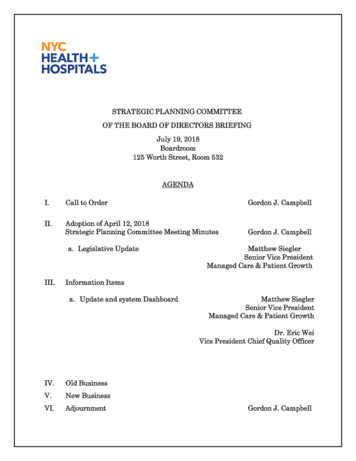
Transcription
Topics in Metrics forSoftware Testing[Reading assignment: Chapter 20, pp. 314-326]
Quantification One of the characteristics of a maturingdiscipline is the replacement of art byscience. Early physics was dominated byphilosophical discussions with noattempt to quantify things. Quantification was impossible until theright questions were asked.
Quantification (Cont’d) Computer Science is slowly followingthe quantification path. There is skepticism because so much ofwhat we want to quantify it tied to erratichuman behavior.
Software quantification Software Engineers are still countinglines of code. This popular metric is highly inaccuratewhen used to predict:– costs– resources– schedules
Science begins withquantification Physics needs measurements for time,mass, etc. Thermodynamics needs measurementsfor temperature. The “size” of software is not obvious. We need an objective measure ofsoftware size.
Software quantification Lines of Code (LOC) is not a good measuresoftware size. In software testing we need a notion of sizewhen comparing two testing strategies. The number of tests should be normalized tosoftware size, for example:– Strategy A needs 1.4 tests/unit size.
Asking the right questions When can we stop testing?How many bugs can we expect?Which testing technique is more effective?Are we testing hard or smart?Do we have a strong program or a weak testsuite? Currently, we are unable to answer thesequestions satisfactorily.
Lessons from physics Measurements lead to Empirical Lawswhich lead to Physical Laws. E.g., Kepler’s measurements ofplanetary movement lead to Newton’sLaws which lead to Modern Laws ofphysics.
Lessons from physics (Cont’d) The metrics we are about to discussaim at getting empirical laws that relateprogram size to:– expected number of bugs– expected number of tests required to findbugs– testing technique effectiveness
Metrics taxonomy Linguistic Metrics: Based on measuringproperties of program text without interpretingwhat the text means.– E.g., LOC. Structural Metrics: Based on structuralrelations between the objects in a program.– E.g., number of nodes and links in a controlflowgraph.
Lines of code (LOC) LOC is used as a measure of softwarecomplexity. This metric is just as good as source listingweight if we assume consistency w.r.t. paperand font size. Makes as much sense (or nonsense) to say:– “This is a 2 pound program” as it is to say:– “This is a 100,000 line program.”
Lines of code paradox Paradox: If you unroll a loop, you reduce thecomplexity of your software . Studies show that there is a linearrelationship between LOC and error rates forsmall programs (i.e., LOC 100). The relationship becomes non-linear asprograms increases in size.
Halstead’s program lengthH n1 log 2 n1 n 2 log 2 n 2n1 the number of distinct operators (keywords)in the program. (Paired operators (begin . end)are treated as a single operator.)n 2 the number of distinct operands (data objects)in the program.WARNING : Program Length ! LOC
Example of program lengthif (y 0)pow - y;elsepow y;z 1.0;while (pow ! 0) {z z * x;pow pow - 1;}if (y 0)z 1.0 / z;n1 9 (if, , ,- (sign), while,! , *, - (minus), /)n 2 7 (y, 0, pow, z, x, 1, 1.0)H 9 log 2 9 7 log 2 7 48
Example of program lengthfor ( j 1; j N; j ) {last N - j 1;for (k 1; k last; k ) {if (list[k] list[k 1]) {temp list[k];list[k] list[k 1];list[k 1] temp;}}}n1 9 (for, , , , -, , [], , if)n 2 7 (j, 1, N, last, k, list, temp)H 9 log 2 9 7 log 2 7 48
Halstead’s bug prediction(N1 N 2 ) log 2 (n1 n 2 )B 3000n1 the number of distinct operatorsn 2 the number of distinct operandsN1 the total number of operatorsN 2 the total number of operandsExponentiation Example:(16 21) log 2 (9 7)B ! 0.049 bugs3000Bubble Sort Example:(25 31) log 2 (9 7)B ! 0.075 bugs3000
How good areHalstead’s metrics? The validity of the metric has beenconfirmed experimentally many times,independently, over a wide range ofprograms and languages. Lipow compared actual to predicted bugcounts to within 8% over a range ofprogram sizes from 300 to 12,000statements.
Structural metrics Linguistic complexity is ignored. Attention is focused on control-flow anddata-flow complexity. Structural metrics are based on theproperties of flowgraph models ofprograms.
Cyclomatic complexity McCabe’s Cyclomatic complexity isdefined as: M L - N 2P L number of links in the flowgraph N number of nodes in the flowgraph P number of disconnected parts of theflowgraph.
Property of McCabe’s metric The complexity of several graphsconsidered together is equal to the sumof the individual complexities of thosegraphs.
Examples ofcyclomatic complexityL 1, N 2, P 1M 1-2 2 1L 4, N 4, P 1M 4-4 2 2L 2, N 4, P 2M 2-4 4 2L 4, N 5, P 1M 4-5 2 1
Cyclomatic complexityheuristics To compute Cyclomatic complexity of aflowgraph with a single entry and a singleexit:M ! 1 total number of binary decisions Note:– Count n-way case statements as N binarydecisions.– Count looping as a single binary decision.
Compound conditionals Each predicate of each compound conditionmust be counted separately. E.g.,A&B&CAAAAAAA&B&CA&B&CB&CBB&CB&CCBM 2CCM 3M 4
Cyclomatic complexity ofprogramming constructs21. if E thenAelseB2. C2M 21. case E of2.a: A3.b: B k.k-1: Nl. end casem. L1211. loopA2. exit when EB3. end loop4. C323M 2.KlmM (2(k-1) 1)-(k 2) 2 K-11. ABC 2. ZM 1412
Applying cyclomatic complexity toevaluate test plan completeness Count how many test cases are intended toprovide branch coverage. If the number of test cases M then one ofthe following may be true:– You haven’t calculated M correctly.– Coverage isn’t complete.– Coverage is complete but it can be done withmore but simpler paths.– It might be possible to simplify the routine.
Warning Use the relationship between M and thenumber of covering test cases as aguideline not an immutable fact.
Subroutines &MMain NodesMain LinksSubnodesSublinksEmbeddedCommon PartNm kNcLm kLc00Main MSubroutine M Lm kLc-Nm-kNc 20Total MLm kLc-Nm-kNc 2Subroutine forCommon PartNmLm kNc 2LcLm k-Nm 2Lc-Nc-2 2 Lc-Nc McLm Lc-Nm-Nc k 2
When is the creation of asubroutine cost effective? Break Even Point occurs when the totalcomplexities are equal: The break even point is independent ofthe main routine’s complexity.L m kL c - N m - kN c 2 L m L c - N m - N c k 2k(L c - N c ) L c - N c kk(L c - N c - 1) L c - N ck(M c - 1) M ckM c - k M ckM c - M c kM c (k - 1) kMc kk -1
Example If the typical number of calls to asubroutine is 1.1 (k 1.1), the subroutinebeing called must have a complexity of11 or greater if the net complexity of theprogram is to be reduced.1.1Mc 111.1 - 1
Cost effective subroutines(Cont’d)k 1, M c "(creating a subroutine you only call once isnot cost effective)2k 2, M c 21(break even occurs when M c 2)3k 3, M c 1.521000k 1000, M c !1999(for more calls, M c decreases asymptotically to 1)
Cost effective subroutines(Cont’d)The relationship between M c and k :k1Mc 1 k -1k -1
Relationship plotted as a functionMc101k Note that the function does not make sensefor values of 0 k 1 because Mc 0! Therefore we need to mention that k 1.
How good is M? A military software project applied the metricand found that routines with M 10 (23% ofall routines) accounted for 53% of the bugs. Also, of 276 routines, the ones with M 10had 21% more errors per LOC than thosewith M 10. McCabe advises partitioning routines withM 10.
Pitfalls if . then . else has the same M as aloop! case statements, which are highlyregular structures, have a high M. Warning: McCabe’s metric should beused as a rule of thumb at best.
Rules of thumb based on M Bugs/LOC increases discontinuously forM 10 M is better than LOC in judging life-cycleefforts. Routines with a high M (say 40) should bescrutinized. M establishes a useful lower-bound rule ofthumb for the number of test cases requiredto achieve branch coverage.
Software testingprocess metrics Bug tracking tools enable the extraction ofseveral useful metrics about the software andthe testing process. Test managers can see if any trends in thedata show areas that:– may need more testing– are on track for its scheduled release date Examples of software testing process metrics:––––Average number of bugs per tester per dayNumber of bugs found per moduleThe ratio of Severity 1 bugs to Severity 4 bugs
Example queries applied to abug tracking database What areas of the software have the mostbugs? The fewest bugs? How many resolved bugs are currentlyassigned to John? Mary is leaving for vacation soon. How manybugs does she have to fix before she leaves? Which tester has found the most bugs? What are the open Priority 1 bugs?
Example data plots Number of bugs versus:––––fixed bugsdeferred bugsduplicate bugsnon-bugs Number of bugs versus each major functionalarea of the t arithmeticetc
Example data plots (cont’d) Bugs opened versus date opened over time:– This view can show: bugs opened each day cumulative opened bugs On the same plot we can plot resolved bugs,closed bugs, etc to compare the trends.
You now know the importance of quantification various software metrics various software testing processmetrics and views
Software testing process metrics Bug tracking tools enable the extraction of several useful metrics about the software and the testing process. Test managers can see if any trends in the data show areas that: -may need more testing -are on track for its scheduled release date Examples of software testing process metrics:










